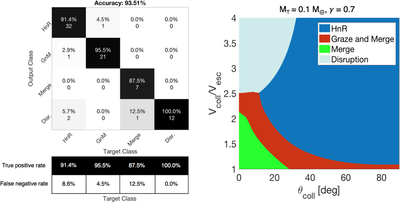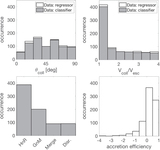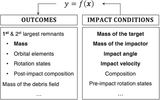Image Details

Caption: Figure 4.
Left-hand panel: confusion matrix of the 4D classifier, quantifying the degree of accuracy of the classification on the testing set. The elements on the diagonal of the confusion matrix represent those instances that have been correctly classified by the SVM (true positives). Conversely, each extra-diagonal element represents the number of misclassifications with respect the SPH data (i.e., the labels). The number of misclassifications is added along each column to compute the false negative rates. Overall, we achieve a true positive rate of 91.4% on the hit-and-run (HnR) class, 95.5% for the graze-and-merge (GnM) class, 87.5% for the merge class and 100.0% for the disruption class. The confusion matrix is close to be fully diagonal; the accuracy—which is computed as the mean value of the true positives over the whole population, Equation (10)—is above 93%. Right-hand panel: decision boundaries for the collision type, as predicted by the classifier for a mass of the target MT = 0.1 M⊕ and a mass ratio between the projectile and the target γ = 0.7. The impact velocity spans a range between 1 and 4 times the mutual escape velocity (Equation (1)) while the impact angle ranges from head-on to grazing configurations.
Copyright and Terms & Conditions
© 2019. The American Astronomical Society. All rights reserved.









